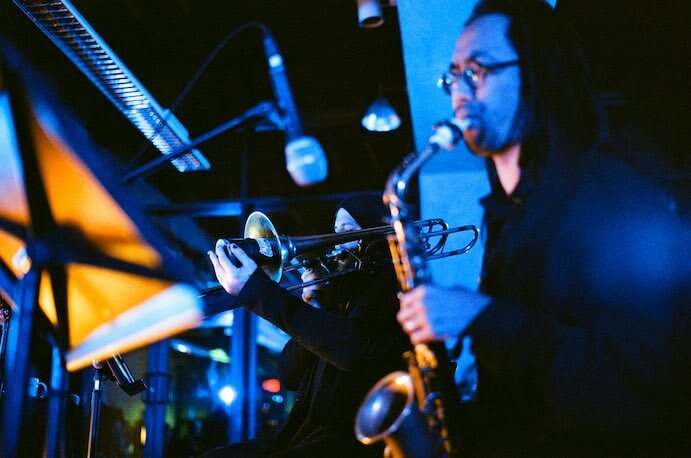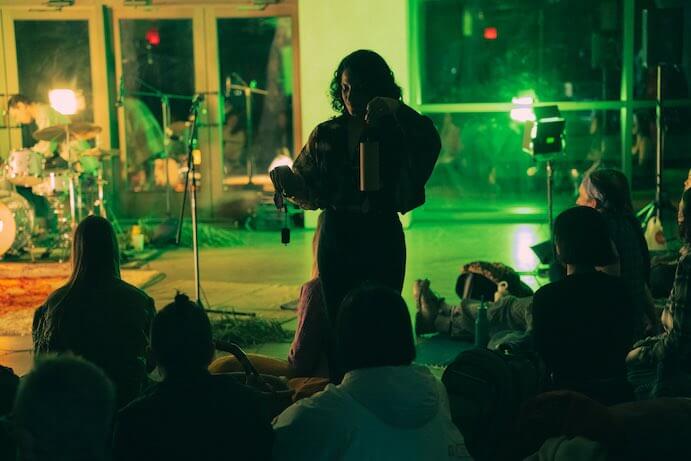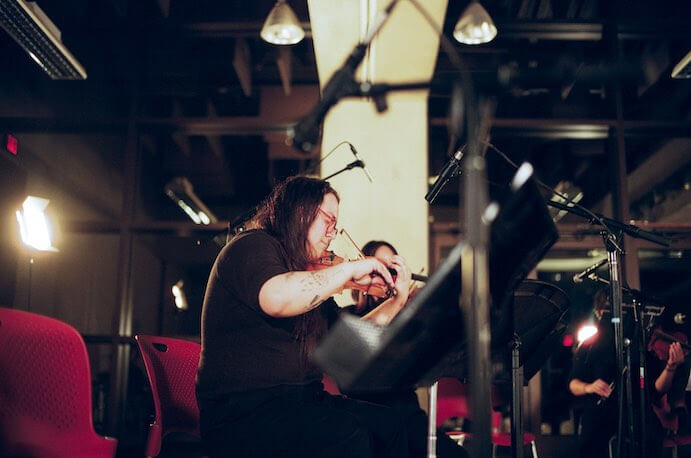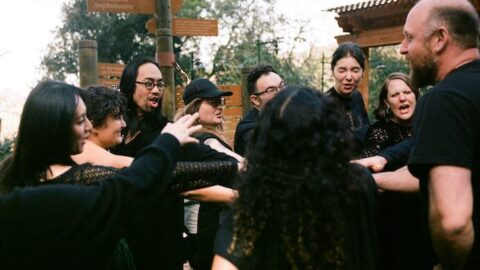I’m not a nature person, so it was with trepidation that I trekked up the Santa Monica Mountains for Darkness Sounding, Wild Up’s four-day music festival co-presented with the outdoor art series Floating. Spanning two separate weekends from Jan. 19 – 28, this year’s installment of Darkness Sounding took place at the headquarters of TreePeople, an environmental organization that protects parks, restores ecosystems, and plants over 10,000 trees a year. In this case, the venue was not merely a physical hosting space — it was an integral part of the festival. Attendees were encouraged to arrive early to check out the trails, explore Coldwater Canyon Park, and learn about environmental advocacy at the TreePeople information tables.
As dusk settled before the first sunset show (aptly scheduled for 5:37pm), we gathered on cushions and blankets in the Center for Community Forestry, where Wild Up artistic director and conductor Christopher Rountree talked about the intent behind the festival. “There’s an interesting feeling in Los Angeles in the winter,” he started. “We’re not getting a full East Coast winter and we’re not trudging through snow, but I feel drawn into my own space, like I don’t want lights on after 6pm, like I’m receding into the dark.” He posited that the winter darkness breeds a special kind of mindfulness — one that he wished to share with the community through these musical experiences surrounded by nature.
claire rousay’s electronic set left me feeling particularly reflective. Sitting behind a laptop in the center of the room, rousay draped the audience in warm, shimmering waves texturized with soft sizzles and delicate crackles. She wove in voice memos, melodic giggles, and other found sounds atop a base of dulcet tones and plaintive piano chords. I marveled at the variety-yet-cohesion of rousay’s soundscapes, not to mention the clarity with which we were able to hear them. The live house mix was fantastic; four large speakers faced inward from the corners of the room, lending to an immersive surround sound. When rousay piped in a voice memo, the recorded voice danced from speaker to speaker, highlighting different parts of the narrative for people in different parts of the room.

Four members of Wild Up then joined rousay onstage for the US premiere of her work crying. At first, I wasn’t sure if the piece had even begun, as the players filed onstage with their cases and removed their instruments at their seats; however, this turned out to be part of the presentation.
rousay initiated a subtle mechanical whirr, and bassoonist Archie Carey began to read text: “It’s 4pm on a Monday, and I cannot stop sobbing. I haven’t been able to eat or sleep or leave the bed for days.” One by one, each player began to read from the same text, each starting at the beginning of the script and performing it in a round. Amid the babble, a heart-wrenching phrase jumped out at me: “My life is becoming the very life I have dreamed about since I was a little kid. I so badly wish I could engage, appreciate, and truly live this life that I’ve been fortunate enough to experience.”
As rousay’s high-pitched whirr grew more piercing, the players each picked up pens and began to scribble on close mic’d paper; then, they picked up their instruments and played sustained individual tones that together formed chords. Eventually, rousay replayed voice snippets of everyone delivering the text while the players noisily put their instruments away — the still-hot mics amplifying every swish, zipper pull, and stand hit — and unceremoniously walked offstage without smiling or acknowledging each another. It was a poignant representation of the shared yet solitary experience of depression. Everything about this performance, from the script and music to the staging and direction, exemplified rousay’s artistry and — crucially — Rountree and Wild Up’s earnest engagement with the work they present.

This level of thoughtfulness also extended to the curation of the festival; it was Rountree’s idea to form the one-night supergroup of singer Odeya Nini, saxophonist Patrick Shiroishi, and drummer Booker Stardrum, and as a fan of each of these artists separately, I was very curious to hear what they would do together. Their evening-length co-composition, Orison (Prayer), had the audience transfixed; it began with a meditative concoction of chimes and bells, with Nini and Shiroishi walking throughout the audience and jingling the objects in front of our faces as if making offerings.
The rest of the piece was largely improvised, anchored by a loose structure and extended solos from each artist. It was hard to look away from the captivating Nini, whose throat rumbled, vibrated, and gurgled, at times producing sounds that seemed impossible. Her hands danced as if spinning tones while beckoning, cradling, and pushing away invisible energy. She flipped between vocal extremes with absurd dexterity and cold clarity. At one point, Shiroishi followed her lead, mimicking her Hail Mary high notes on the saxophone and nose-diving in tandem with careening glissandi; the duo execution felt like an exciting dare to see where they’d jump and where they’d land. Stardrum performed a free jazz solo with impressive dynamic contours and shook eucalyptus branches sourced from the trees outside.

Half of the audience, myself included, was laying down by the end of the piece, which ended with oscillating synth chords and the sound of slow breathing/purring. Nini let a full 45 seconds of silence pass before she essentially woke everyone from their trance by whispering “thank you” twice into the microphone. While rousay’s concert made me turn inward and contemplate the meaning of human existence, Nini, Shiroishi, and Stardrum’s performance rooted me to the present.
To close the festival, we were treated to back-to-back concerts (on either side of sunset) featuring the music of Leilehua Lanzilotti and inti figgis-vizueta. The pairing of these two composers was intentional, and the concerts were meant to be in dialogue with each other. Rountree explained that Lanzilotti and figgis-vizueta draw from a collaborative pool of methods, aiming to democratize music-making and center individual agency for performers.
Lanzilotti’s concert was the only one to take place in the S. Mark Taper Foundation Amphitheater — a lovely outdoor space surrounded by oak and pine trees — and it was the only performance that made our relationship to the environment explicit. She started with a living land acknowledgement (delivered first in Hawaiian, then English) that included a reflection on what action she was taking on the land she was standing on — in this case, she was presenting music about Indigenous language revitalization. Taking a step further to include the audience, she shared a resource for how to find out who originally inhabited the lands we live on, too.

In the amphitheater, players were positioned to create an acoustic surround sound, starting with four players onstage and six players behind the audience. Lanzilotti’s music was mostly quiet, textural, and delicate, and it fit beautifully in the environment of unpredictable, natural, and manmade sounds, from birds to cars to low-flying planes passing overhead and adding white noise. Her introductions added context that enriched the listening experience and gave me things to ponder — for example, I learned that Hawaii is one of the most diverse rain climates in the world, and thus, there are hundreds of words for “rain” in Hawaiian.
figgis-vizueta’s concert showcased the range of her work, including a mesmerizing string sextet (secret music, originally for quartet) that explored a plethoric combination of timbres and pitch movement. With Lanzilotti on viola and figgis-vizueta leading on violin, the ensemble played a morphing stream of tremolos that phased in and out of synchronicity in satisfying and hair-raising ways. In you are the water, cello soloist Derek Stein shredded chords, scurried through chromatic lines, and slid up and down the harmonic series, his raucous and confident interpretation of the aleatoric score exemplifying the essentiality of the performer in figgis-vizueta’s work. Rountree may have had the most fun of all in ensemble forecast, channeling Mickey Mouse a la The Sorcerer’s Apprentice while he conducted the controlled chaos.

The only concert that missed the mark for me was the opening double bill featuring mattie barbier and Ellen Arkbro. An evening of drones under the stars may have been pleasant if not for weather in the 50s and an uncomfortable seating area, and I almost didn’t have the stamina to make it through the three 20+ minute drone pieces. As is often the case, the music itself wasn’t the problem — it was the context, or in this case, the dearth of context. barbier, a trombonist and composer, seemed genuinely engaged with what they were doing, and I wished that they had shared a bit more about their pieces or euphonium preparations with the audience. figgis-vizueta’s concert would have benefitted from more information about the compositions, as well – perhaps digital program notes could be added to the festival in the future?
Given the success of this year’s festival, I’m curious to see what Wild Up has in store for Darkness Sounding in the future. I may have gone into the festival grumbling about the dirt and bemoaning my soft city shell, but by the last day, I was chatting with the TreePeople volunteers and filling up packets of seeds to take home and scatter in my neighborhood.
I CARE IF YOU LISTEN is an editorially-independent program of the American Composers Forum, funded with generous donor and institutional support. Opinions expressed are solely those of the author and may not represent the views of ICIYL or ACF.
A gift to ACF helps support the work of ICIYL. For more on ACF, visit the “At ACF” section or composersforum.org.
























